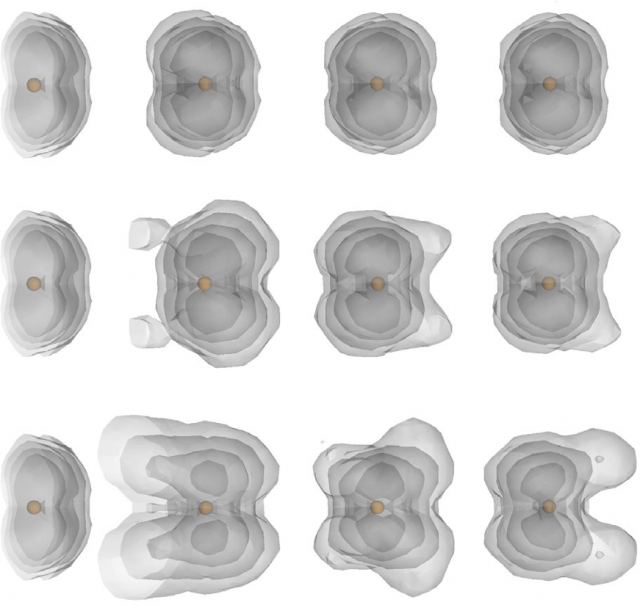The role of core electrons in the electronic stopping power of heavy ions

Spacecraft components potentially exposed to different ionic projectiles in space, new materials used in new energy systems or healthy tissues exposed to cancer therapies are all instances where a full comprehension of how the energy of the incoming ions is dissipated by the matter in the target is of paramount importance. Besides, the dissipative processes in ion irradiation of matter is an interesting problem from the point of view of fundamental physics.
The most dominant channel of energy dissipation for a swift ion shooting through matter is the interaction with the electronic degrees of freedom of the target. The energy loss to these electrons is formally known as electronic stopping power and is defined as the energy lost by the projectile per unit path length. It is measured in electronvolts per ångström (eV/Å).
The electronic stopping power of light ions shooting through simple metals in the low-velocity regime is relatively well understood using linear response and nonlinear response formalisms. The linear and nonlinear response approaches have been refined but essentially remain limited in practice to simple metals and simple ions.
More sophisticated approaches, such as the so-called time-dependent tight-binding method, the linear-response time-dependent density functional theory or real-time time-dependent density functional theory, have been used trying to solve the problem of electronic stopping power. These approaches have been very successful in describing the electronic stopping power of systems exposed to light projectiles (H, He), with electronic stopping power values of the order of 10 eV/Å.
The role of the core and semicore electrons of the target even with light projectiles in the stopping process has been shown to be quite significant. Actually, an explicit treatment of semicore and core electrons of the target atoms is essential for the calculation of stopping power at high projectile velocities. On the other hand, it has been shown that the core electrons of the projectile play an important role as well.
Nickel (Ni) based alloys are known for their radiation tolerance, thermal stability, and optimal mechanical properties, making them promising candidate materials for the next generation energy and aerospace applications. The presence of Ni in structural alloys is known to play an important role in mitigation of swelling under irradiation. Nickel, along with iron and tungsten, is the subject of extensive radiation damage research for energy applications.
Now Rafi Ullah (CIC Nanogune, UPV/EHU), Ikerbasque Research Professor Emilio Artacho (University of Cambridge, CIC nanoGune, DIPC) and Alfredo Correa (Lawrence Livermore National Laboratory) investigate 1 the effect of core electrons for both the target and the projectile within real-time time-dependent density functional theory in the case of self-irradiated nickel (a Ni projectile shooting through a Ni target). The electronic stopping power of self-irradiated Ni is predicted to be in the range of keV=Å. Till this work, no material with electronic stopping power values in the keV=Å range has ever before been simulated beyond linear response.

There are no direct experimental data available for the stopping power of Ni in Ni, except for the element-wise interpolations of the stopping and range of ions in matter (SRIM) model, which makes the prediction of these simulations ever more important. The SRIM model shows that in self-irradiated Ni, nuclear stopping is dominant for velocities up to 1 atomic unit (a.u.) and quickly diminishes beyond it. The researchers considered the velocity regime range 1.0–12.0 a.u. (which corresponds to energies in the range 1.5–210 MeV) in which the electronic stopping power becomes dominant and accounts for almost all of the total stopping power.
The researchers found that, for Ni, like other transition metals that show a very high electronic stopping power, core electrons have a major contribution in it, particularly those of the projectile.
Author: César Tomé López is a science writer and the editor of Mapping Ignorance.
References
- Rafi Ullah, Emilio Artacho and Alfredo A. Correa (2018) Core Electrons in the Electronic Stopping of Heavy Ions Physical Review Letters doi: 10.1103/PhysRevLett.121.116401 ↩
1 comment
[…] Cómo se disipa la energía de los átomos e iones que impactan en las superficies metálicas de las naves espaciales, en los nuevos materiales en los nuevos sistemas de obtención de energía o en los tejidos humanos sometidos a […]